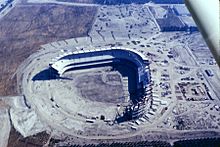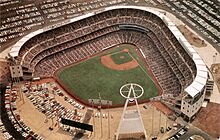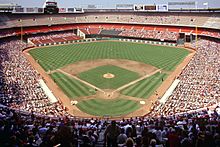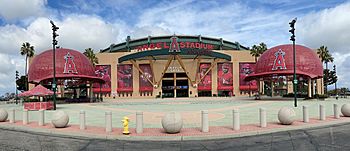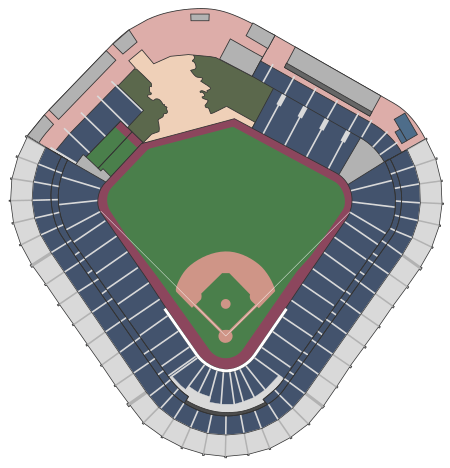Angel Stadium facts for kids
|
The Big A
|
|
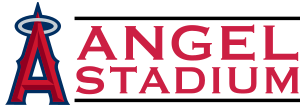 |
|
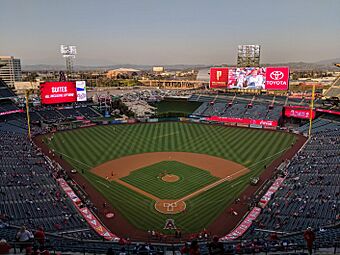
Angel Stadium in 2019
|
|
| Former names | Anaheim Stadium (1966–1997) Edison International Field of Anaheim (1998–2003) |
|---|---|
| Address | 2000 Gene Autry Way |
| Location | Anaheim, California, United States |
| Coordinates | 33°48′1″N 117°52′58″W / 33.80028°N 117.88278°W |
| Public transit | |
| Owner | City of Anaheim |
| Operator | Angels Baseball LP |
| Capacity | 43,250 (1966) 64,593 (Baseball—1980) 69,008 (Football—1980) 45,517 (2019–present) |
| Record attendance | Baseball: 64,406 October 5, 1982 (ALCS Game 1) |
| Field size | Left Field – 347 ft (105.8 m) Left-Center – 390 ft (118.9 m) Center Field – 396 ft (120.7 m) Right-Center – 370 ft (112.8 m) Right-Center (shallow) – 365 ft (111.3 m) Right Field – 350 ft (106.7 m) Backstop – 60.5 ft (18.4 m) 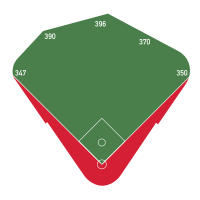 |
| Surface | Tifway 419 Bermuda Grass |
| Construction | |
| Broke ground | August 31, 1964 |
| Opened | April 19, 1966 April 1, 1998 (renovations) |
| Construction cost | US$24 million ($155 million in 2021 dollars ) $118 million (1997–1999 renovations) ($186 million in 2021 dollars ) |
| Architect | Noble W. Herzberg and Associates (1966) HOK Sport Robert A. M. Stern, and Walt Disney Imagineering (Renovations) |
| General contractor | Del E. Webb Company (1966) Turner Construction Company (Renovations) |
| Tenants | |
| Los Angeles Angels (MLB) (1966–present) Orange County Ramblers (CoFL) (1967–1968) Cal State Fullerton Titans football (NCAA) (1970–1971, 1983) Southern California Sun (WFL) (1974–1975) Long Beach State 49ers football (NCAA) (1977–1982) California Surf (NASL) (1978–1981) Los Angeles Rams (NFL) (1980–1994) Freedom Bowl (NCAA) (1984–1994) |
|
Angel Stadium is a famous baseball park in Anaheim, California. It's often called The Big A by fans. Since it opened in 1966, it has been the home of the Los Angeles Angels baseball team. The Angels were the first Major League Baseball (MLB) team to start in California.
Before moving to Anaheim, the Angels played in Los Angeles. They played at Wrigley Field (Los Angeles) for one season. Then they played at Chavez Ravine Stadium (also known as Dodger Stadium) for four seasons. Construction on Angel Stadium began in 1964.
From 1980 to 1994, the stadium was also home to the Los Angeles Rams football team.
Angel Stadium is one of the oldest active baseball parks in the major leagues. Only Fenway Park, Wrigley Field, and Dodger Stadium are older. It has hosted the MLB All-Star Game three times. These were in 1967, 1989, and 2010. The stadium also hosted the World Series in 2002, which the Angels won!
Besides baseball and football, Angel Stadium has hosted many other big events. Famous musicians like The Who and Pink Floyd have performed there. The Rolling Stones and Aerosmith have also played concerts. It's also a popular spot for the AMA Supercross Championship. This exciting motorcycle race has been held there since 1976.
Religious events, like the annual Harvest Crusades, also take place at the stadium. Eid al-Fitr celebrations have brought thousands of people for morning prayers. College and high school football games have been played here too. In 2024, the Savannah Bananas, a fun exhibition baseball team, announced they would play games at Angel Stadium in 2025.
The stadium even has the offices and studios for the Angels' own radio station, KLAA (830 AM).
Contents
Where is Angel Stadium?
Angel Stadium is located in Anaheim, California. It's surrounded by several streets and a freeway. Katella Avenue is to the north, and the Orange Freeway is to the east. Orangewood Avenue is to the south, and State College Boulevard is to the west.
The Big A Sign
A famous landmark called the "Big A" sign stands near the stadium. It used to hold the scoreboard in left field. Now, it's in the parking lot, next to the Orange Freeway. This sign is 230-foot (70 m) tall and weighs 210 tons!
At the top of the "Big A" is a halo. For many years, it would blink after dark when the Angels won a game. If they lost, it would stay lit without blinking. Since at least 2023, the halo stays lit all the time. But it shines brighter when the Angels win!
Getting to the Stadium
The ARTIC is a transportation hub nearby. It serves Metrolink and Amtrak trains. You can easily get to the stadium from ARTIC. It's also close to the Honda Center and Disneyland.
A Look Back: Stadium History
How it All Started
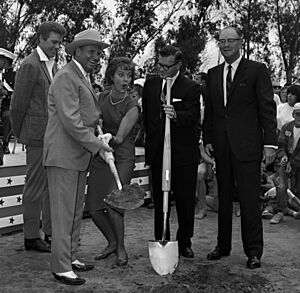
Angel Stadium became the Angels' home when they moved from Los Angeles. Groundbreaking for the stadium happened on August 31, 1964. The Angels moved into their new home in 1966. Before that, they rented Dodger Stadium from the Dodgers. In their very first season in 1961, the Angels played at Wrigley Field (Los Angeles).
The stadium was first called Anaheim Stadium. In 1997, its name changed to Edison International Field. Then, after the 2003 season, it became Angel Stadium.
The stadium was built on about 160 acres (0.65 km2) of farmland. It's in a suburban area, but close to big tourist spots.
The field's size was carefully planned by the Angels. They wanted a field that was fair for both pitchers and hitters. They even considered the air density during games! The Angels have made small changes to the outfield over the years.
The center field is 396 feet (120.7 m) away from home plate. This is one of the shortest center fields in the American League. Despite this, Hall of Fame pitcher Nolan Ryan threw two of his seven no-hitters here. He also had 2,416 strikeouts in this ballpark.
When the Rams Played Here
In the late 1970s, the Los Angeles Rams football team needed a new home. Their old stadium was too big. So, a deal was made for the Rams to move to an expanded Anaheim Stadium. To fit football games, about 23,000 more seats were added. The stadium became fully enclosed.
The "Big A" scoreboard was moved to the parking lot. A new scoreboard with a video screen was put in left field. Later, a bigger Sony Jumbotron screen replaced it in 1988.
These changes made the stadium less ideal for baseball fans. Seats were further from the field. Even with more seats, many remained empty for most games.
The Rams played in Anaheim Stadium from 1980 until 1994. They then moved to St. Louis. The Rams returned to Los Angeles in 2016. They now play in the new SoFi Stadium in Inglewood.
In 1994, an earthquake caused the left-field Jumbotron to fall. Luckily, no one was hurt because it happened early in the morning when the stadium was empty. The damaged section was rebuilt with a new scoreboard.
The Disney Era and Renovations
In 1996, The Walt Disney Company took control of the Angels team. Disney owned Disneyland nearby and the Mighty Ducks of Anaheim hockey team. The Angels and Anaheim agreed to a new deal. This deal would keep the Angels in Anaheim.
As part of the deal, the stadium got a huge makeover. It was changed back to a baseball-only park. The section behind the outfield wall was taken down. This brought back views of the mountains and hills.
The renovations continued through 1997. New outfield bleachers and video boards were added. All the colorful seats were replaced with green ones. The outside of the stadium was also updated.
The most exciting new feature was the "California Spectacular." This area behind left-center field has geysers and a stream flowing down a mountainside. Fireworks shoot from this display at the start of games. They also go off after every Angels home run and win!
The main entrance now has two giant Angels hats. Inside the stadium, there are statues of former Angels owner Gene Autry and Michelle Carew. Michelle was the daughter of former Angel Rod Carew.
The Angels opened their "new" stadium on April 1, 1998. They won 4–1 against the New York Yankees. The renovated stadium has 5,075 club seats and 78 luxury suites.
In 1998, the stadium was renamed Edison International Field. This was because a company called Edison International bought the naming rights. Fans sometimes called it "The Big Ed." But in 2003, Edison International ended the deal. On December 29, 2003, the stadium officially became Angel Stadium again. Disney also sold the Angels team around this time.
Modern Upgrades
In 2009, new light emitting diode (LED) displays were installed. The main video screen is 41 ft (12.50 m) high and 67 ft (20.42 m) wide.
Between 2017 and 2018, the video boards were upgraded again. The new right field board is 9,500 sq ft (880 m2). This makes it the fourth-largest scoreboard in MLB! New video ribbons and a new sound system were also added.
The Angels extended their lease until 2032. This means the team will continue to play at Angel Stadium for many more years.
Seating Capacity
| Years | Capacity |
|---|---|
| 1966–1978 |
43,202
|
| 1979 |
43,250
|
| 1980–1985 |
65,158
|
| 1986–1987 |
64,573
|
| 1988–1996 |
64,593
|
| 1997 |
33,851
|
| 1998–2005 |
45,050
|
| 2006–2007 |
45,262
|
| 2008–2009 |
45,281
|
| 2010–2011 |
45,389
|
| 2012 |
45,957
|
| 2013–2014 |
45,483
|
| 2015 |
45,957
|
| 2016 | 45,493 |
| 2017–2018 | 45,477 |
| 2019–present | 45,517 |
Exciting Events at Angel Stadium
Baseball Highlights
Angel Stadium hosted the 1967 MLB All-Star Game. This was the first All-Star Game ever shown on prime-time television. It also hosted All-Star Games in 1989 and 2010.
The stadium has seen many important baseball games. It hosted seven American League Division Series and six American League Championship Series. Most famously, it hosted the 2002 World Series, which the Angels won!
In 2006, Angel Stadium hosted games for the World Baseball Classic.
On August 9, 2014, the longest game ever at the stadium took place. It lasted 6 hours and 31 minutes! The Angels won 5-4 against the Boston Red Sox in 19 innings.
Many famous baseball players have achieved milestones here. Mickey Mantle hit his final game-winning home run. Nolan Ryan struck out nine Boston Red Sox players in a row. He also threw two of his seven career no-hitters here. Reggie Jackson hit his 500th home run. Rod Carew got his 3,000th hit. Don Sutton earned his 300th win. Vladimir Guerrero hit his 400th home run. George Brett got his 3,000th hit. And Albert Pujols hit his 600th home run.
More recently, Shohei Ohtani has made history at Angel Stadium. In 2021, he became the first player since Babe Ruth in 1919 to hit 30+ home runs and pitch in 10+ games in one season. That same year, he was the first player ever chosen for the All-Star Game as both a pitcher and a hitter. In 2022, Ohtani became the first player in AL and NL history to hit 30 home runs and win 10 games as a pitcher in a single season.
Angel Stadium is set to host baseball events for the 2028 Summer Olympics.
Football Memories
A "Battle of the Bell" high school football game was played here in the 1970s. It was between Fountain Valley High School and Edison High School.
Eric Dickerson broke the NFL single-season rushing record here in 1984. He finished that game with 2,007 yards!
In December 2017, the Philadelphia Eagles even used Angel Stadium as their practice field.
Soccer Matches
Anaheim Stadium hosted five group stage matches for the 1996 CONCACAF Gold Cup. This included two games with the United States national team.
| Date | Winning Team | Result | Losing Team | Tournament | Spectators |
|---|---|---|---|---|---|
| January 10, 1996 | 3–1 | 1996 CONCACAF Gold Cup First Round | 27,125 | ||
| 3–2 | |||||
| January 13, 1996 | 3–2 | 12,425 | |||
| January 16, 1996 | 3–0 | 52,345 | |||
| 2–0 |
Concerts and Music
Angel Stadium has hosted many concerts. Bands like The Rolling Stones, The Who, David Bowie, and U2 have played here. Other artists include The Osmonds, Pink Floyd, Alice Cooper, The Grateful Dead, Madonna, and the Eagles.
| Date | Artist | Opening act(s) | Tour / Concert name | Attendance / Capacity | Revenue | Notes |
|---|---|---|---|---|---|---|
| June 14, 1970 | The Who | — | Tommy Tour | — | — | |
| March 21, 1976 | — | The Who by Numbers Tour | — | — | ||
| July 17, 1976 | Yes | Peter Frampton, Gary Wright, Gentle Giant | 1976 Solo Albums Tour | — | — | Hosted by Flo & Eddie |
| August 7, 1976 | ZZ Top | Blue Öyster Cult Johnny & Edgar Winter |
Worldwide Texas Tour | 49,169 / 60,000 | $498,040 | |
| August 20, 1976 | Kiss | Bob Seger & the Silver Bullet Band Ted Nugent Montrose |
Destroyer Tour | 42,000+ | — | |
| September 10, 1976 | Aerosmith | Jeff Beck | Rocks Tour | — | — | |
| September 12, 1976 | ||||||
| May 6, 1977 | Pink Floyd | — | In the Flesh Tour | — | — | |
| May 7, 1977 | ||||||
| June 19, 1977 | Alice Cooper | Nazareth The Tubes & Sha Na Na |
King of the Silver Screen Tour | — | — | |
| August 27, 1977 | Lynyrd Skynyrd | — | Street Survivors Tour | |||
| July 23, 1978 | The Rolling Stones | — | Some Girls Tour | — | — | |
| July 24, 1978 | The Outlaws | |||||
| September 23, 1978 | Boston | Black Sabbath | Never Say Die! Tour | — | — | This concert was part of Summerfest. |
| September 24, 1978 | ||||||
| July 17, 1982 | Scorpions Loverboy Foreigner |
Iron Maiden | Summer Strut featuring Blackout Tour The Beast on the Road |
73,351 / 73,351 | $1,100,265 | |
| September 9, 1983 | David Bowie | The Go-Go's Madness |
Serious Moonlight Tour | — | — | |
| July 18, 1987 | Madonna | Level 42 Bhundu Boys Hue and Cry |
Who's That Girl World Tour | 62,986 / 62,986 | $1,417,185 | |
| July 26, 1987 | The Grateful Dead Bob Dylan |
— | Alone and Together Tour | — | — | A portion of this show has been recorded for the album, View from the Vault, Volume Four |
| August 8, 1987 | David Bowie | Siouxsie and the Banshees | Glass Spider Tour | 50,000 | — | |
| August 9, 1987 | — | |||||
| November 14, 1992 | U2 | The Sugarcubes Public Enemy |
Zoo TV Tour | 48,640 / 48,640 | $1,462,800 | |
| April 17, 1993 | Paul McCartney | — | The New World Tour | 48,560 / 48,560 | $1,698,410 | |
| June 13, 1998 | NSYNC | — | NSYNC in Concert | — | — | This concert was a part of Wango Tango |
| November 2, 2002 | The Rolling Stones | Sheryl Crow | Licks Tour | — | — | |
| May 14, 2005 | Kelly Clarkson | Graham Colton Band | Breakaway World Tour | — | — | This concert was a part of Wango Tango |
| November 4, 2005 | The Rolling Stones | Toots and the Maytals | A Bigger Bang Tour | 48,480 / 48,480 | $6,792,416 | |
| June 17, 2011 | U2 | Lenny Kravitz | U2 360° Tour | 105,955 / 105,955 | $10,790,140 | |
| June 18, 2011 | ||||||
| July 14, 2012 | Kenny Chesney Tim McGraw |
Grace Potter and the Nocturnals Jake Owen |
Brothers of the Sun Tour | 44,832 / 44,832 | $3,963,039 | |
| July 27, 2013 | Kenny Chesney Eric Church |
Eli Young Band Kacey Musgraves |
No Shoes Nation Tour | 41,447 / 41,447 | $3,538,806 | |
| September 9, 2017 | Chance the Rapper | — | Be Encouraged Tour | — | — | These concerts were part of the Day N Night Festival. |
| SZA | Ctrl the Tour |
Movies Filmed Here
Several movies have used Angel Stadium as a filming location. The end of The Naked Gun: From the Files of Police Squad! (1988) was filmed here. The 1988 sci-fi comedy My Stepmother Is an Alien also has a scene shot at the stadium.
The 1990 comedy Taking Care of Business showed a World Series game here. The Disney remake of Angels in the Outfield (1994) features the ballpark a lot. Scenes from The Fan (1996) and Air Bud: Seventh Inning Fetch were also filmed here.
Other Fun Events
In 1979, Anaheim Stadium hosted a motorcycle speedway event. This was a qualifying round for the 1980 Speedway World Championship.
The stadium has hosted the AMA Supercross Championship many times since 1976. It's also a regular spot for Monster Jam shows.
Angel Stadium has been the site of annual Christian Harvest Crusades since 1990. It has also hosted Muslim Eid el Fitr celebrations. In 2014, Barack Obama gave a commencement speech for University of California, Irvine graduates here.
The stadium also holds an annual 5K run. The course goes through the stadium and around its parking lot.
Regular Season Home Attendance
|
||||||||||||||||||||||||||||||||||||||||||||||||||||||||||||||||||||||||||||||||||||||||||||||||||
Images for kids
See also
 In Spanish: Angel Stadium of Anaheim para niños
In Spanish: Angel Stadium of Anaheim para niños






